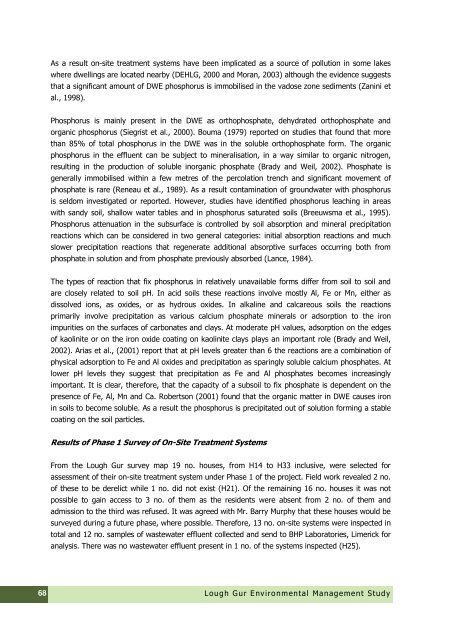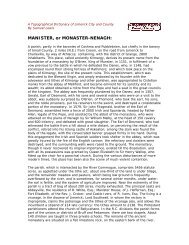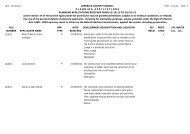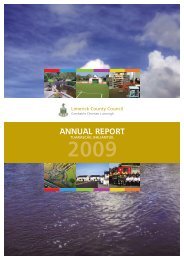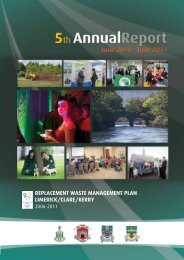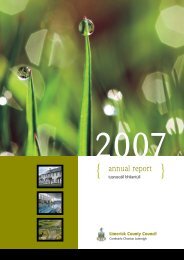Lough Gur Environmental Management Study February 2009
Lough Gur Environmental Management Study February 2009
Lough Gur Environmental Management Study February 2009
You also want an ePaper? Increase the reach of your titles
YUMPU automatically turns print PDFs into web optimized ePapers that Google loves.
68<br />
As a result on-site treatment systems have been implicated as a source of pollution in some lakes<br />
where dwellings are located nearby (DEHLG, 2000 and Moran, 2003) although the evidence suggests<br />
that a significant amount of DWE phosphorus is immobilised in the vadose zone sediments (Zanini et<br />
al., 1998).<br />
Phosphorus is mainly present in the DWE as orthophosphate, dehydrated orthophosphate and<br />
organic phosphorus (Siegrist et al., 2000). Bouma (1979) reported on studies that found that more<br />
than 85% of total phosphorus in the DWE was in the soluble orthophosphate form. The organic<br />
phosphorus in the effluent can be subject to mineralisation, in a way similar to organic nitrogen,<br />
resulting in the production of soluble inorganic phosphate (Brady and Weil, 2002). Phosphate is<br />
generally immobilised within a few metres of the percolation trench and significant movement of<br />
phosphate is rare (Reneau et al., 1989). As a result contamination of groundwater with phosphorus<br />
is seldom investigated or reported. However, studies have identified phosphorus leaching in areas<br />
with sandy soil, shallow water tables and in phosphorus saturated soils (Breeuwsma et al., 1995).<br />
Phosphorus attenuation in the subsurface is controlled by soil absorption and mineral precipitation<br />
reactions which can be considered in two general categories: initial absorption reactions and much<br />
slower precipitation reactions that regenerate additional absorptive surfaces occurring both from<br />
phosphate in solution and from phosphate previously absorbed (Lance, 1984).<br />
The types of reaction that fix phosphorus in relatively unavailable forms differ from soil to soil and<br />
are closely related to soil pH. In acid soils these reactions involve mostly Al, Fe or Mn, either as<br />
dissolved ions, as oxides, or as hydrous oxides. In alkaline and calcareous soils the reactions<br />
primarily involve precipitation as various calcium phosphate minerals or adsorption to the iron<br />
impurities on the surfaces of carbonates and clays. At moderate pH values, adsorption on the edges<br />
of kaolinite or on the iron oxide coating on kaolinite clays plays an important role (Brady and Weil,<br />
2002). Arias et al., (2001) report that at pH levels greater than 6 the reactions are a combination of<br />
physical adsorption to Fe and Al oxides and precipitation as sparingly soluble calcium phosphates. At<br />
lower pH levels they suggest that precipitation as Fe and Al phosphates becomes increasingly<br />
important. It is clear, therefore, that the capacity of a subsoil to fix phosphate is dependent on the<br />
presence of Fe, Al, Mn and Ca. Robertson (2001) found that the organic matter in DWE causes iron<br />
in soils to become soluble. As a result the phosphorus is precipitated out of solution forming a stable<br />
coating on the soil particles.<br />
Results of Phase 1 Survey of On-Site Treatment Systems<br />
From the <strong>Lough</strong> <strong>Gur</strong> survey map 19 no. houses, from H14 to H33 inclusive, were selected for<br />
assessment of their on-site treatment system under Phase 1 of the project. Field work revealed 2 no.<br />
of these to be derelict while 1 no. did not exist (H21). Of the remaining 16 no. houses it was not<br />
possible to gain access to 3 no. of them as the residents were absent from 2 no. of them and<br />
admission to the third was refused. It was agreed with Mr. Barry Murphy that these houses would be<br />
surveyed during a future phase, where possible. Therefore, 13 no. on-site systems were inspected in<br />
total and 12 no. samples of wastewater effluent collected and send to BHP Laboratories, Limerick for<br />
analysis. There was no wastewater effluent present in 1 no. of the systems inspected (H25).<br />
<strong>Lough</strong> <strong>Gur</strong> E nvironmental <strong>Management</strong> <strong>Study</strong>


